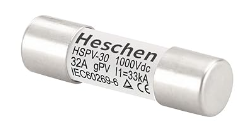Johan
Off-grid energy systems enthusiast.
Per request of @Pi Curio, 10 Heschen fuses (sourced on Amazon; HSPV-30; 32A; 1000VDC; I1 = 33kA) were blown while mounted in their DIN-rail fuse holders (sourced on Amazon) in the vertical position.


These fuses are filled with sand, similar to Class T fuses. The resulting current versus time plot is shown below. The legend shows the experiment number. Experiments 1 through 4 blow a single fuse. Experiment 5, 6, and 7 blow two fuses in series just to see if that makes any difference.

Here are all seven experiments on video ("Unlisted" on Youtube, so you need to use this link):
Notes:


These fuses are filled with sand, similar to Class T fuses. The resulting current versus time plot is shown below. The legend shows the experiment number. Experiments 1 through 4 blow a single fuse. Experiment 5, 6, and 7 blow two fuses in series just to see if that makes any difference.

Here are all seven experiments on video ("Unlisted" on Youtube, so you need to use this link):
Notes:
- There was no sign of external damage for fuses and holders.
- Only experiment 5 has measurement data from both the Arduino and oscilloscope for comparison purposes.
- The negative 25000A "charge current" was completely unexpected and seemed to be artificial oscilloscope nonsense at first, but this current was later reproduced on the Arduino (not shown, separate experiment). This *may* be an effect or "ringing" due to parasitic capacitance in the circuit. Anybody comments on this?
- Scopes are generally very inaccurate for measuring voltages, so they are also inaccurate for measuring voltage drops across a shunt as was done here to calculate the current.
- I estimate the Arduino accuracy to be roughly +/- 160A based on specsheets data.
- The oscilloscope accuracy seems to be roughly +/- 1800A based on specsheets data.
- See also here if you want to read more about oscilloscope accuracy.
- When torquing the screws, the side panel of the thin plastic fuse holder housing can easily crack open.


